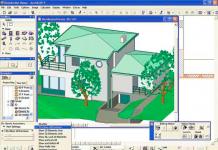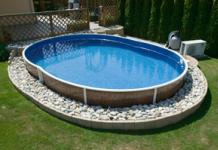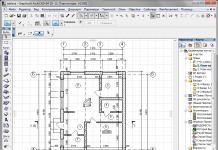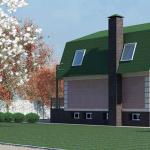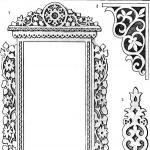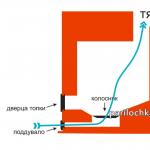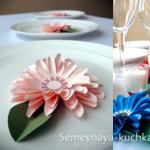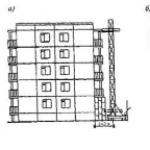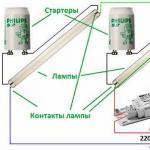During the hot season, it is always nice to spend time in cool water. But it may not always be possible to go to a river or other body of water. In this case, the best option would be to build a swimming pool at your dacha or on the site of a country house. You will always have your own pond at hand where you can relax. In this article we will talk about how you can inexpensively make a pool in your country house.
Types of designs
Before answering the question of how to build a swimming pool at your dacha with your own hands, you must decide on the type of structure itself. The choice of material and work technology will depend on this. As an option we can offer the following types of pools:
- Frame. Such designs can be purchased ready-made. A frame pool is a metal structure with a stretched fabric (usually PVC film). The kit may include a ladder, cleaning system, pumping station, etc. This design is installed for the season. The pool is already equipped with waterproofing; you just need to assemble the structure and pump water into it;
- Plastic products. This option is a bowl made of polymer materials. The container can be purchased ready-made or ordered from a specialized company. Similar models, like the previous version, are installed for the season. It is better not to leave a plastic container for the winter;
- Stationary. This type can be considered a real pool. Of course, its creation will require a lot of physical and financial effort from you, but as a result, a large body of water will appear in your dacha or garden plot where you can swim.
One of the options can be considered inflatable structures. But such pools are not so comfortable due to their small size. And the quality of inflatable structures is often poor. Having pumped up the pool in the evening, in the morning you may find in its place a piece of rubberized material lying helplessly on the ground.
Choosing the optimal size and location
Since it is the stationary pool that can be considered “real,” then further discussion will focus on this option. If you have decided on the type, then you should think about the installation location and the size of the artificial reservoir itself.
The choice of location largely depends on the wishes of the owner. Many people install a pool behind the house, near the recreation area. But when choosing a place it is important consider some factors. Namely:
- Priming. Much will depend on its properties. Firstly, it is better that the soil is clay. In this case, you will receive additional natural waterproofing. Secondly, when creating a permanent pool, you will have to dig a pit. If the selected area has rocky soil, then the work can be quite complex and time-consuming, especially if you do it yourself;
- Predominant wind direction. Since the pool will be located in an open area, there is a high probability of various debris getting into it. So that when swimming you do not encounter debris from scraps of paper or dry leaves, it is better that the artificial pond is protected from the prevailing wind direction;
- Presence of nearby vegetation. It is better that there are no bushes and especially trees near the reservoir. Plants are always drawn to moisture, and their roots are quite strong and can easily break through the concrete thicket of the pool.
If we are talking about the size of an artificial reservoir, then there are no special requirements. Everything will depend on the availability of free land and your preferences. For example, for swimming along one lane it is quite suitable width two and a half meters and a length of 5 meters. If there are two tracks, then the width increases to 4 meters.
The optimal depth of the pool can be considered 1.4 meters. But even here everything will depend on the purposes for which you are building a reservoir. If you have children and the main purpose of the pool will be to entertain them, then you should not make it too deep. Conversely, if you are a diving enthusiast, then depth will play a very important role.
Stages of pool construction
In general terms, the process of constructing a permanent pool can be broken down into the following stages:
- Selecting the type of reservoir and drawing up its design. At the same time, a suitable site for construction is selected.
- Marking on the ground. Excavation.
- Arranging formwork and pouring the pool bowl.
- Applying a waterproofing layer to the surface and finishing the bowl.
- Equipping the pool with equipment and lighting.
As you can see, there is a lot of work. Moreover, each stage is important, because not only the appearance of the structure and the duration of its operation will depend on it.
Excavation and bowl creation
Now let's move on to considering the question itself - how to make a pool with your own hands. When you have decided on the size and installation location, then Let's start excavation work. First of all, we apply markings to the area. To do this, you can use pegs and a stretched rope.
Next, we move on to excavation work. This is one of the most labor-intensive stages of construction. You have to dig a pit of the required size and depth. It is worth considering that the width, length and depth must be made approximately half a meter larger. This additional space is necessary for the installation of formwork. If the size of the pool you are planning is quite impressive, then you should think about using special equipment.
After the pit is ready, you can start creating the bowl future pool. This stage of work includes the following activities:
- The bottom and walls of the pit are carefully compacted.
- A pillow is made from sand. To do this, a layer of material 20-30 cm thick is poured onto the bottom and compacted thoroughly.
- A waterproofing layer is applied over the cushion at the bottom and over the entire surface of the walls. Today on the market you can find many materials that become an excellent barrier to water. The use of roofing felt and bitumen mass can be considered the most budget-friendly. Such materials have been used for a long time and have proven themselves well. A layer of roofing material is laid over the entire surface (on the bottom and walls, the latter should be covered with material to the very top with a margin). Then several (preferably 3-4) layers of bitumen mass are applied.
- The next step will be the installation of the drainage system. This must be done before installing the formwork. How many drain holes to make and where to place them will depend on the size and shape of the pool bowl.
- Next, we install the formwork, which can be made from scrap materials. After installing the formwork, we begin pouring concrete. In this case, it is necessary to use reinforcement. In order for the bowl to serve for a long time, it is necessary to use concrete of the appropriate grade and with additives.
After the concrete mass hardens the formwork is removed. Next, you need to treat the entire surface of the resulting bowl with a solution of concrete and water or iron it. At this point, the main stages of creating a pool can be considered complete. Next comes the finishing and equipping of the structure.
Finishing and lighting
 Now you need to finish the pool bowl. But before this, an additional layer of waterproofing is applied. It is very important to seal every crack to prevent water from damaging the bowl. For these purposes you can use impregnating materials, film or mastic.
Now you need to finish the pool bowl. But before this, an additional layer of waterproofing is applied. It is very important to seal every crack to prevent water from damaging the bowl. For these purposes you can use impregnating materials, film or mastic.
After waterproofing, you can begin finishing work. Ceramic tiles are most often used to cover the pool bowl. This material can easily withstand prolonged exposure to water, is easy to clean and has an attractive appearance.
In addition to ceramic tiles, you can also use modern materials, for example, PVC film. Modern manufacturers produce a wide range of similar materials. It is strong and durable. And if we talk about colors and designs, then there is always plenty to choose from.
The finishing work itself can be completed, but it is better to equip the pool additional equipment. This kit usually includes:

Don’t forget to arrange the area around the new artificial pond. As a rule, it is also covered with ceramic tiles. But here it is important to choose an option with an anti-slip coating. This way you will reduce the risk of injury.
As a conclusion
A swimming pool in a country house or on a personal plot is a great place to relax on hot summer days. And making it with your own hands is not so difficult. You can build an artificial pond from scrap materials, but it is better and more reliable to make it from concrete. Make calculations, make markings, dig a pit, fill the bowl and finish. Here are the main stages of work. With a little effort and financial investment, you will have a wonderful vacation spot for the whole family.
For many summer residents, building their own concrete pond at the dacha, in which after a hard day you can swim in cool water and relax, is an almost impossible dream. After working by car, they have to look for a lake or river, the water level of which is not always suitable for swimming, and the cleanliness of the water surface is far from ideal. But you can build a swimming pool with your own hands!
And then the attributes of a relaxing holiday that you thought were available only at resorts - an outdoor pond, a comfortable sun lounger, a cocktail in a glass covered with drops of dew - will become available. We often see this picture in films, when on a hot day children frolic in the water and adults sunbathe in sun loungers, and we mentally imagine ourselves in the place of the characters in the series.
If you make a pool with your own hands, building a structure is not a difficult job, then you can enjoy relaxing by the water. Of course, you will have to spend money, make efforts, and then it will turn out that nothing is impossible in realizing this idea.
If you are ready, all that remains is to select from the proposed types of structures the one that will meet the requirements and fit into the landscape of the site. Let's consider what options can be implemented by doing the work with your own hands in the country.

During the hot season it is always nice to spend time in cool water
Design selection problem
Choosing the optimal construction option is a serious job that precedes the implementation of construction activities. Let's take a closer look at the possible types of structures:
- An inflatable option, characterized by an affordable price, ease of transportation, fast operating times, but having a limited service life of the base.
- Frame prefabricated structure, which is popular. The surface of the structure is larger than the inflatable bowl and has a rigid base and walls.
- A monolithic classic container is a concrete bowl, which is manufactured by specialists. It can have a different design, be equipped with additional lighting systems and water flow.
- The plastic or acrylic version of the structure is made of polypropylene and fiberglass composites, is easy to install, and looks original. The bowl is sealed, the surface is easy to clean with water, and does not require special finishing.
All designs of artificial reservoirs can be divided depending on:
- location involving construction outdoors or indoors;
- depth to which the structure is immersed. Structures are divided into three types, which include: inflatable; frame structures installed on the surface; slightly recessed, intended for children and deep, of which stationary ones are representatives;
- according to the method of water circulation. Sometimes surface cleaning of the top layer is carried out, or an overflow option is used, when water is filtered along the entire contour of the structure.

Priming. Much will depend on its properties. Firstly, it is better that the soil is clay
If you have not yet decided which pool is best to make, or how to start work, let’s get to know these issues in more detail. In order for an artificial pond to be enjoyable, it is important to design it correctly, carry out its construction, and equip it with equipment.
Location determination
Construction of a pool bowl requires choosing the optimal location on the site. Consider the following points that affect the operating conditions of the reservoir:
- The presence of vegetation, including large trees, which, if there is a lack of moisture, can stretch their roots to the water, disrupting the hydraulic insulation of concrete. Fallen leaves promote the growth of algae and, when decomposed, pollute the pond. Even daily water filtration will not be able to ensure the necessary cleanliness of concrete walls.
- The type of soil on which construction is carried out. Give preference to clay soils, which provide a waterproofing layer and do not absorb water well, which helps with the appearance of cracks in concrete structures.
- The direction of wind currents that blow debris to a specific location. In accordance with the wind rose, install an overflow pipe in the reservoir, allowing you to collect garbage along with the water.
- The depth of water layers, at a low level (0.5-1 m from the zero level), is not recommended for the construction of concrete pools.
Also, pay attention to the proximity of the foundations of buildings located on the site. Concrete pools require the construction of a pit, which, if located close to the foundation of the building, can compromise the strength of the foundation and cause cracks to appear on the surface of the walls.

If the selected area has rocky soil, the work may be quite difficult.
Configuration selection
Many developers, when constructing a concrete structure, having seen enough non-standard shapes of artificial reservoirs in magazines, want to embody original ideas. Remember that the intricate configuration causes difficulties not only when installing a concrete structure, but also in the process of water purification.
The complex shape of a reservoir requires the correct selection of filters, determination of the required pump power, and the elimination of stagnant zones. There will be a need to frequently purchase chemical reagents.
If during construction you build a rectangular, oval or round shape, then these problems will not arise. An unusual staircase design or a peculiar curve can add a “zest” to the design of the reservoir, making it original.
Geometric dimensions
When thinking about the size of the reservoir, be guided by the recommendations given:
- Considering the purpose, determine the preliminary dimensions. If you plan to use the pond for swimming, then a rectangular or elongated shape is better. For family rest and relaxation, round shapes are preferable;

If we are talking about the size of an artificial reservoir, then there are no special requirements
- The depth of the reservoir is a serious criterion. With a depth of one and a half meters, you can painlessly turn around under the surface of the water, swim, and jump from the sides. If you want to set up a small springboard, worry about a deep bowl (2.5 m). You can make a gradual transition from the general depth to the diving zone;
- when building swimming pools with your own hands, intended for children, ensure a depth of 0.5 m, which will avoid unforeseen situations in the water;
- The production of pools made in a combined form will allow adults and children to take water treatments at the same time. A special feature of the reservoir is the presence of two zones separated by a partition, which will protect against accidental access of children to the adult bathing area.
With different depths of the concrete bottom, a gentle transition between sections should be made. Sudden changes in depth are not allowed, creating the possibility of unexpectedly going under water, when a person in a panic could choke.
Construction of a concrete structure
A swimming pool on a country plot or dacha has ceased to be a curiosity. They install it step by step and thoroughly on their own or invite craftsmen. If you want to make a personal pond with your own hands, arm yourself with instructions and detailed photos.
In general, all types of pools that can be installed on a summer cottage are conventionally divided into:
- frame;
- foundation pits
The first ones are good because they are removed for the winter, and can also change their location every season. They are located completely or partially on the surface of the earth. Such frames are expensive, although some owners manage to make them with their own hands. Pit pools require a lot of work as they require digging a hole.
Some examples of ponds for summer cottages:
- inflatable pool - similar to a frame one, easy to install and inexpensive, but has a short service life;
- fiberglass - looks like a monolithic bowl, the installation of which requires digging a pit. Transportation causes certain inconvenience due to the dimensions of the structure;
 Plastic pool
Plastic pool - plastic – durable and lightweight. Its structure resembles fiberglass, which is why it has difficulties in delivery and installation;
- concrete is a suitable option for those who are planning to install a high-quality pool on a suburban area. It can be made from individual blocks or as a monolithic structure. Difficult to install, but definitely reliable and durable.
Attention! If installed incorrectly, a concrete pit pond may leak water or fill poorly. To prevent this from happening, you need to lay all the pipes correctly and take care of high-quality waterproofing.
Main stages of construction: digging a pit, insulation, pool filter
Instructions for installing a concrete pool:
- Choosing a location. It is good if it is in an open, sunny area, away from trees: their roots can destroy the bowl, and the foliage will become a constant source of debris.
- Determination of sizes. The optimal depth for a pond in which adults will swim is from 1.5 m. In this case, the waterproofing layer must be taken into account. The length and width can vary and be, for example, 4x4 m or 4x5 m.
 Pool pit
Pool pit - Calculation of the thickness of the walls and bottom, which depends on the depth of the reservoir, the level of groundwater and soil quality.
- Design of a drainage system, location of communications, steps and lighting.
- Marking boundaries. To do this, just drive in pegs at the site of the future reservoir.
- Excavation work. You can dig a pit manually if the pool is small, but it is better to use special equipment. The hole should be wider and deeper than the project suggests. For example, the walls need to be increased by 04.-0.5 m.
Advice. To prevent the soil from crumbling, dig a pit taking into account the slope of the walls towards the center. Provide a place for drainage, as well as the possibility of draining water, for which the bottom should have a slope towards the drainage system.
- Bottom leveling and waterproofing. You need to pour a mixture of sand and gravel in a layer of 0.3 m and compact it tightly. Then apply roofing material in 2-3 layers, overlapping the walls by 15-20 cm. Bitumen or liquid rubber are also suitable.
- Installation of formwork along the edges of the pool. For it, you can take boards or plywood, which will allow you to make a pool of any shape. Before starting work, you need to carefully take care of the drainage system.
- Reinforcement of the walls of the future reservoir with rods with a diameter of 0.8-1.4 mm.
 Interior decoration of the pool bowl
Interior decoration of the pool bowl - Pouring concrete into the space between the formwork and the ground.
- Removing the formwork after the concrete mixture has hardened and ironing the walls - treating them with cement and grouting with water. This will add strength to the structure.
- Reinforcement and filling of the pool bottom. Installation of metal stairs.
- Decorating the surface of the bowl with PVC film, mosaic or tiles.
Advice. You can first reinforce and fill the bottom with concrete, and then the walls. If you plan to descend into the pool along concrete steps, then the formwork for them needs to be prepared separately, after the bowl is ready.
To build a pool from individual concrete blocks you need:
- Dig a pit, level its bottom and fill it with concrete.
- Lay walls of blocks, reinforcing every 3rd row.
- Build a staircase into one of the walls.
- Waterproof and decorate the pool bowl.
A polypropylene pond can be equipped in two ways:
- buy a ready-made bowl and install it;
- purchase a sheet of polypropylene and make a container of the desired shape and size from it.
 Construction of a concrete pool
Construction of a concrete pool In any case, the installation of such a pool consists of the following steps:
- Digging a hole whose dimensions exceed the size of the bowl.
- Waterproofing the bottom and filling it with concrete.
- Installation of the bowl.
- Installation of drain and nozzles for water supply.
- Insulation of pool edges and pipes.
- Connecting communications and pouring concrete.
Attention! To make the walls even, you need to make formwork inside the bowl and pour concrete in stages, to a height of 0.3-0.35 cm per day.
Any pool must be equipped with a filter, otherwise the water will soon become dirty and unsuitable for swimming. You need to pass it through a cleaning device using a pump 2-3 times a day, even if no one has swum in the pond. Today there are 3 main types of filter units:
- sand ones are quite voluminous and are used mainly in public swimming pools. They look like a container filled with sand, where gravel, silver sand, etc. can be added;
 Choose the right pool filter
Choose the right pool filter - cartridge - purify water using propylene membranes. They are small in size and can be installed outside the reservoir itself. Clogged cartridges need to be changed frequently;
- Diatomaceous earth filters are the most expensive filters, consisting of several cartridges. Water is purified from most microbes using diatomite soil with silicon dioxide.
Advice. The main criterion for choosing a filter is performance (volume of water passed through). It is indicated by the manufacturer.
Pool skimmer: purpose, types
Like a filter, a skimmer purifies water from bacteria, but only processes the top layer of the surface. It also dampens waves when several people are swimming. The skimmer looks like a metal or plastic tank with a water intake pipe. It is equipped with a filter for deep cleaning of debris, insects, and leaves.
The skimmer can be:
- hinged - often used for frame or inflatable pools;
- built-in - used during the installation of a pit reservoir.
 Pool skimmer
Pool skimmer Typically, manufacturers include a drawing with the device, according to which the skimmer can be assembled. It must be installed at the stage of pouring the walls with concrete. It is necessary to provide boxes for openings. A plywood shield is prepared under the skimmer, which is then installed into the pool bowl together with the attached device.
Advice. One skimmer cleans 25 sq. m of water. If the volume of the pool is larger, you will need several devices.
As you can see, setting up a pool is quite a troublesome task. However, by studying the instructions and selecting the necessary materials, you will be able to cope with this task.
Ideas for building a swimming pool at the dacha: video
In the summer, when the weather is quite hot outside, it is especially pleasant to be in cool water. However, it is not always possible to go out into nature, where you can swim to your heart’s content in a river or any other body of water. An excellent alternative to this is your own pool, located on a summer cottage, or on the territory of your country cottage. But to do it, you need to have certain skills and knowledge, which will be discussed in this article.
Before we begin describing the procedure for building your own pool on your site, I would like to talk about the types of structures that you can install at your place. Each of them has its own characteristics, which naturally affects the materials used and manufacturing technology. There are several main types:
 4. Swimming poolsstationary type
. This type of pool can rightfully be considered a full-fledged pool that can serve its owner for many years. Of course, its construction will require a lot of effort and financial costs, but the results obtained will please everyone.
4. Swimming poolsstationary type
. This type of pool can rightfully be considered a full-fledged pool that can serve its owner for many years. Of course, its construction will require a lot of effort and financial costs, but the results obtained will please everyone.
In principle, this is where the list of types of pools ends. The first three types can be purchased ready-made, so we will not consider them. We are more interested in a stationary pool, the construction of which includes several stages.

Pool location
We have decided on the type of pool. Now we should think about where exactly it will be located on the plot? In addition, an important point will be the size of the future pool, which entirely depends on the individual wishes of the owner, as well as on the size of his own summer cottage.
As a rule, many are inclined to install a pool directly behind the house, but here you need to take into account several nuances:
- Soil properties. A lot depends on its characteristics, because the first stage of work is digging a pit. If the soil contains stones, the work can be very difficult and energy-consuming. The most preferred is clay soil, which has very good waterproofing properties;
- The direction of the wind must be taken into account. It is clear that the wind can be changeable, but when thinking about the location of the pool, it is necessary to take into account those areas where the wind blows quite strongly. If this circumstance is not taken into account, then there will be a lot of foreign objects and small debris in your pool;
- The pool should be located in an area where there are no trees or various shrubs. All plants are drawn to water, so the same tree roots can cause damage to the pool bowl.
As for the size of the future pool, everything depends solely on the wishes of a particular person, as well as the size of his plot. For example, if one swimming lane is enough for you, then two meters is enough for the width of the pool. If there are two tracks, then the width will double, i.e. up to four meters. 
The depth of the pool will also depend on the individual preferences and goals of the owner. In most cases, one and a half meters is enough for the depth, but if you plan to also equip a diving tower, then naturally the depth will be greater. In addition, if you have children, the depth should not be too great, or they should be under your constant supervision while swimming.
What can you build a pool from?
If you intend to equip your own swimming pool at your summer cottage, then you have two options - purchase a ready-made bowl, which is sold in a specialized store, or make this bowl yourself. It should be noted that in both cases it will be necessary to dig a pit.
The advantages of ready-made bowls include ease of installation, environmental friendliness, high reliability characteristics that prevent environmental influences, etc. If we talk about the disadvantages, then such containers are quite ordinary in appearance, so they are not suitable for every person.
That is why many are inclined to make their own pool bowl. One of the options for how all this can be implemented in practice is shown in the following video:
As for the materials needed for work, there are only a few of them:
- Hydroconcrete or cement of a certain grade (C500);
- Sand or crushed stone;
- Ruberoid and bitumen mass;
- Boards and waterproof plywood;
- Reinforcing mesh and wire rod;
- Facing materials - ceramic tiles, mosaics, PVC film, etc.
This is a fairly standard list of the materials that we will need during the construction process. However, the modern building materials market offers a fairly large selection of products that can be used to build a pool bowl. In particular, polystyrene foam blocks, which have proven themselves to be the best in terms of ease of installation and low weight of structures, may be suitable for these purposes.
But we will consider the option of making a bowl using concrete, because... this option looks more traditional and suitable.
How to build a swimming pool with your own hands?
Building a swimming pool with your own hands can be roughly divided into several steps:
- Drawing up a pool project, as well as choosing a site for construction;
- Marking the boundaries of the future pool;
- Excavation work;
- Making formwork, as well as pouring the structure bowl;
- Processing the bowl, as well as applying waterproofing;
- The final stage, which includes the installation of related equipment, lighting, etc.
There is a lot of work, but you shouldn’t neglect any of the stages. The period during which you will enjoy your own pool in your garden will depend on this.
Excavation
 Having decided on the location, you can proceed directly to the work itself. We mark the boundaries of the future pool on the territory using ordinary wooden stakes and a fishing line or rope stretched between them.
Having decided on the location, you can proceed directly to the work itself. We mark the boundaries of the future pool on the territory using ordinary wooden stakes and a fishing line or rope stretched between them.
Now comes the turn of the most labor-intensive and important construction process - earthworks, i.e. digging a pit. At the same time, it is important to understand that all parameters of the pool (length, width and depth) should be made approximately 50 cm larger. This is necessary so that there is space for arranging the formwork. If your pool is small enough, then all the work can be done manually, but if the size is impressive, then you obviously cannot do without special equipment. 

After the concrete has hardened, you can remove our formwork. Then it is necessary to treat the entire surface with a mixture of cement and water, as a result of which we have a waterproofing film.
We line the bottom of the pool with a mesh made of rebar. Then we fill it with concrete so that its thickness is approximately 15-20 cm. 
Bowl lining
Mosaic or ceramic can be used as facing materials. Both options have a right to exist, because they have a fairly attractive appearance and are also very easy to care for.
There are other materials for cladding (for example, PVC films), so the choice remains entirely up to the person himself. To improve the area around the pool, you can plant a lawn.
If you have enough money, then you can equip your pool with additional equipment:
- Water purification system. Typically, this system includes a valve, a filtration tank, a circulation pump and various filters. If you provide such an installation for your pool, you can change the water in the pool much less frequently;
- A flow-type heater that allows you to swim in the pool, regardless of the ambient temperature;
- Illumination around the entire perimeter of the pool will look very advantageous.
Remember that the area around the pool should also be equipped with something. Ceramic tiles with an anti-slip surface are perfect for these purposes, allowing you to avoid possible injuries and falls.
Each craftsman who has built a homemade pool on his site has his own personal preferences and secrets. You can clearly see one of the construction methods if you watch this video:
Making a homemade pool in a summer cottage is a rather labor-intensive process, but it is quite possible to implement it if you follow certain instructions. Of course, certain financial investments will be required on your part, but each of us understands that our own pool is a great way to relax in the summer without leaving your own home or cottage.


